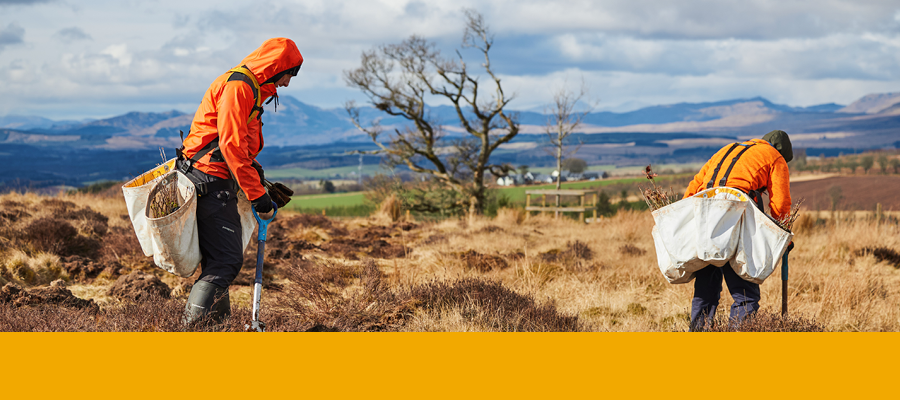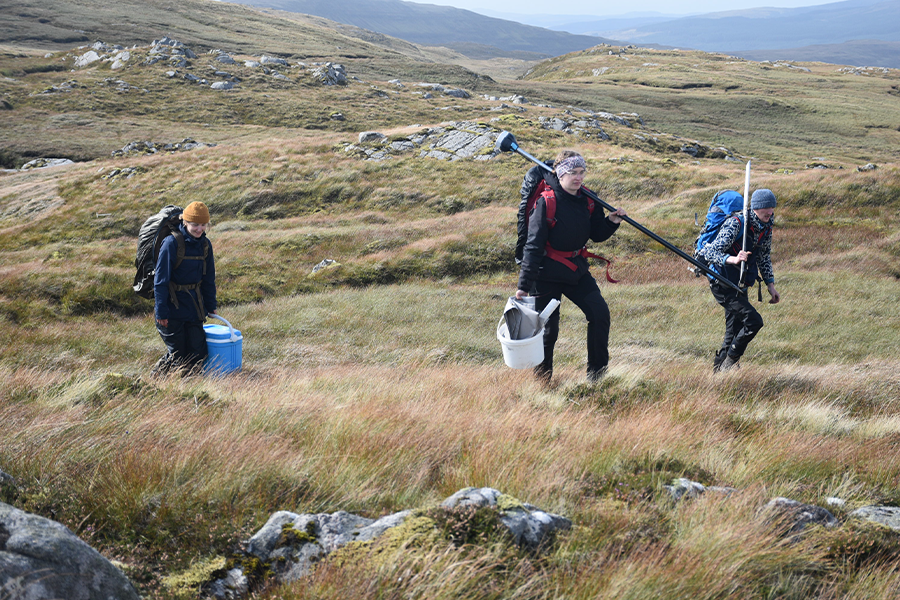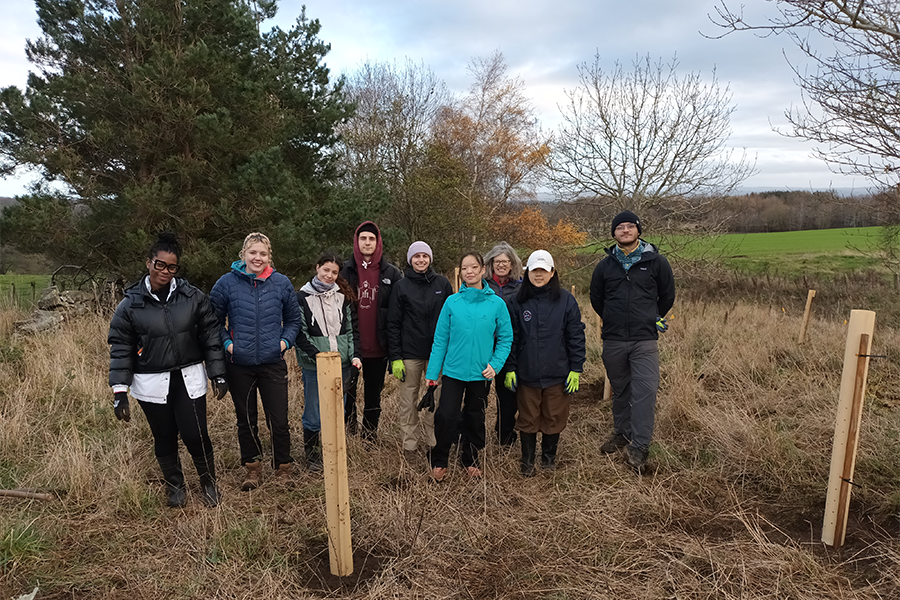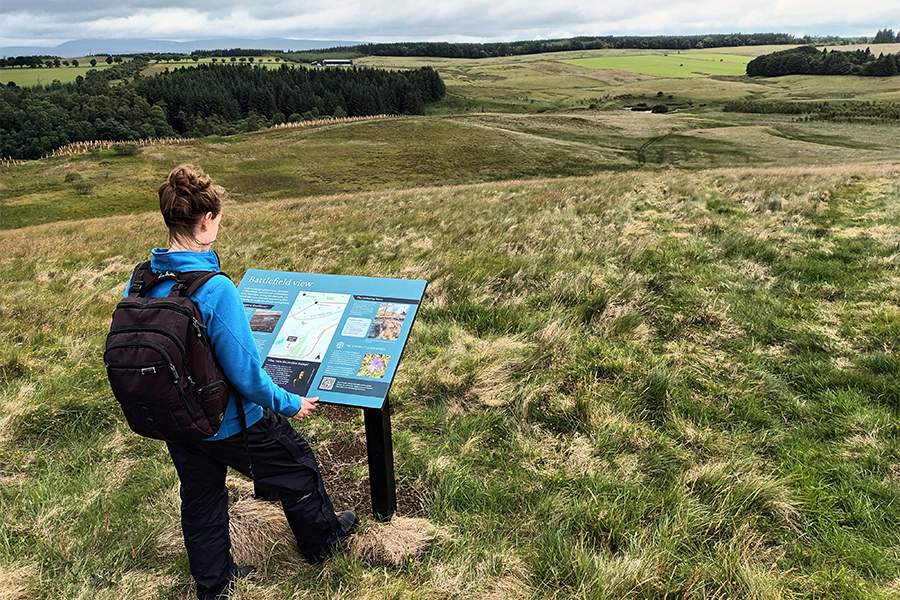Restoring Scotland’s living habitats

Image: Tree planters working at Drumbrae. (Credit: University of Edinburgh)
How the University of Edinburgh’s Forest and Peatland Programme is transforming 5,000 hectares of land and the communities connected to it.
When the University of Edinburgh launched its Forest and Peatland Programme, it set out to rethink how a university can take responsibility for its carbon footprint. Instead of buying carbon offsets elsewhere, the University chose to restore ecosystems here in Scotland, improving biodiversity, strengthening community partnerships and creating rich opportunities for teaching and research.
Only a few years on, the scale of the work is remarkable. Across Scotland, 5,000 hectares of land are now being managed for conservation through the programme, including 891 hectares owned by the University at Drumbrae, Barvick Burn and Rullion Green. The rest is delivered through long-term partnerships with landowners and community organisations, each focused on restoring local habitats and revitalising natural processes. By the end of this winter, the programme expects to have planted more than one million trees across the University-owned sites.
Dr Annie Yang, Academic Manager for the programme, says the wider vision has helped drive momentum. “The project is about more than carbon,” she explains. “It’s also about people, place and long-term stewardship.”
Two habitats, one mission
Woodland creation and peatland restoration sit side by side in the programme, but require different approaches. While healthy peatlands are net carbon sinks, when degraded, they become net carbon sources. Peatlands account for around 20% of Scotland’s land area, but around 80% of it is degraded. Whereas woodlands today cover nearly 19% of land area in Scotland, the Scottish Government has set a target to increase this to 21% by 2032.
Following restoration of degraded peatlands, the impacts are fast-acting, with an almost immediate reduction in emissions. Woodlands, by contrast, take decades to become carbon sinks and require careful design to balance ecological, cultural and social needs. Despite their differences, both habitats share similar management principles, such as reducing herbivore pressure and removing trees planted on peatland in past decades. Annie says: “Peatlands are irreplaceable in many respects, given that they are vital ecosystems whose core value lies in being healthy; while woodlands require more complex decisions involving community use, biodiversity, access, and long-term resilience. Multi-objective policy priorities are shaping how new woodlands must be planned today.”

Dr Nicholle Bell and team for Peatland monitoring research at Ardtornish Estate, Morven FPP partner site (Credit: The Bell group, University of Edinburgh)
Working with communities from the start
Early on, the team encountered questions from local residents. “Some wondered whether the University was becoming a ‘green laird’,” says Julie Wilson, the Programme’s Community Ranger, a term that refers to individuals or businesses that buy up thousands of acres of land to undertake large-scale projects aimed at offsetting their carbon emissions. Raising these general concerns was justified, says Julie, especially given the contentious history of land ownership and use in Scotland.
However, as Julie explains, honest conversations helped build trust: “Because the programme isn’t profit-driven, and because it has multiple objectives beyond carbon, people can quickly see the wider benefits. As the vision became clearer, reservations eased and collaborations grew.”
Monitoring impact over a long timeline
Ensuring the programme delivers what it promises requires detailed, transparent monitoring. The team, along with sector experts, developed a system that goes beyond the Woodland Carbon Code and Peatland Code (government-certified standards for creating high-quality woodland carbon projects in the UK, and for carbon-funded projects that restore degraded peatlands, respectively) incorporating indicators for ecological health, biodiversity and community engagement. The challenge, Annie says, is designing a system that can be replicated across such varied sites.
“The University’s research strengths provide a major advantage,” she says. “High-resolution drone imagery taken by the University’s Airborne Research and Innovation Group forms part of the baseline data. Undergraduate students have also been able to contribute through annual plant surveys as part of their field courses.”
Recent baseline work also helped secure more than £60,000 of funding from NatureScot – the Scottish Government’s adviser on all aspects of nature, wildlife management and landscape – for multi-year peatland monitoring led by Dr Nicholle Bell, supported by PhD research across carbon, biodiversity and social impacts.

Student field course at Barvick Burn Forest and Peatland Programme site (Credit: University of Edinburgh)
Keeping momentum alive
Woodland creation is a long-term task, with some benefits decades away. Julie explains that the programme sustains interest by being a multi-objective programme:
“Volunteer events, archaeological digs, community meetings, research initiatives and teaching activities all help keep the sites active and relevant.
“A key part of that momentum comes from the programme team itself. Having a Community Ranger has been instrumental in early and ongoing engagement with local groups. The Academic Manager role also helps integrate the sites into the University’s teaching and research, providing living lab opportunities.”
Community in action
For Julie Wilson, some of the most rewarding moments have come from the volunteer days. “At Drumbrae, we saw people from the local community as well as groups such as the Scottish Wildlife Trust, mountain rescue teams, trail associations and orienteering clubs all come together to help shape the landscape,” she says. “It’s fantastic to see people of different ages and interests working side by side.”
Public reaction has been equally encouraging, with passers-by often stopping to ask questions or to thank volunteers for their work. Volunteer activities at Rullion Green and Drumbrae have also been hugely popular with staff and students.

Staff and students planting trees at Rullion Green. (Credit: University of Edinburgh)
Designing landscapes for people, nature and heritage
Julie says one of the biggest challenges so far has been the lack of facilities at Drumbrae: “Running activities without shelter or toilets restricts who can participate, especially in changeable weather. Plans are underway for a new Outdoor Learning Facility, along with improved paths, additional planting and sensory experiences. These additions will open opportunities to more people and reduce the barriers that may currently prevent visitors from spending time on the site. We have a vision for this area and strong support from the local community, but we need to raise additional funds to make it a reality.”

Artist’s impression of the proposed outdoor facility at Drumbrae
Balancing public access with landscape protection is another core consideration. Deer fencing is necessary for young woodlands to survive let alone thrive but temporarily alters how people move through the area. Early conversations with residents help the team understand how people use the land, influencing fence lines, gate placement and key viewpoints. New interpretation panels highlight the area’s nature, archaeology and cultural heritage, including a fallen standing stone, burial cairns and battlefields. Story Maps and fixed ‘photo posts’ allow visitors to engage with the site in person and online, capturing how the landscape changes over time.

Interpretation panel overlooking Sheriffmuir Battlefield at Drumbrae. (Credit: University of Edinburgh)
Advice to others: “You need a champion”
When asked what other organisations need to start a programme like this, Annie laughs.
“The short answer is: you need a champion, in our case a Dave.”
She’s referring to Dave Gorman, the University’s Director of SRS, whose leadership helped turned the idea into reality by securing buy-in with the senior team, building the business case, and committing the University to insetting (whereby an organisation reduces its carbon emissions through internal improvements) rather than offsetting.
“Leadership with vision is vital,” she says. “This programme will help meet critical carbon goals contributing to the Universities ambition to be net zero by 2040, but it also delivers nature recovery, community benefits, and opportunities for learning and research. You need someone who sees that bigger picture.”
Support from our community has been vital to the programme’s success to date and we welcome involvement from all who share our vision. To find out more, including how to support this vision, please contact Veronica Royce (Philanthropy Manager) at veronica.royce@ed.ac.uk

